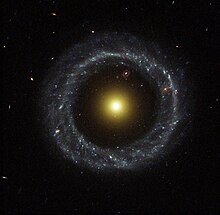Polar ring galaxy
A polar ring galaxy is a rare type of galaxy that results from the merging of two galaxies.
classification
Polar ring galaxies - like tidal arm galaxies, other interacting galaxies and dwarf galaxies - are among the special forms of galaxies in terms of shape. They consist of a central elongated object and a ring or disk of stars that extend perpendicular to this object, i.e. run 'over the pole' of the disk of the central object when viewed from the side. The central objects are mostly lens-shaped of the S0 type in the Hubble sequence , but elliptical or spiral galaxies also occur as central objects . The axes of rotation of the central object and the ring structure are also almost perpendicular to one another. Different galaxy shapes with ring structures are ring galaxies and some bar spiral galaxies , in individual cases the distinction can sometimes be difficult.
To date, only about 100 polar ring galaxies have been discovered. There are sub-types with a large rather spherical central object. They are called the Saturn type. An opposite variant is called the floppy type or sombrero type (see picture NGC 4650A). In this version, the ring is relatively larger and heavier.
According to current knowledge, the Milky Way also has a small ring consisting of gas clouds and oriented perpendicular to its plane of rotation. However, the mass of this ring is very small and therefore does not meet the criteria for classification as a polar ring galaxy.
Emergence
If a galaxy was formed from gas in a single collapse process, a gas disk with a preferred direction of rotation would form, while gas clouds participating in the collapse with a different direction of rotation would collide with the general direction of rotation. A formation in a train of polar ring galaxies with their mutually perpendicular rotation of the ring and central galaxy is therefore unlikely.
Polar ring galaxies are therefore seen as the result of a subsequent merging of two galaxies. In today's cosmology it is assumed that galaxies arise 'hierarchically' from smaller units and merge again and again. Depending on the properties of the two merging galaxies and their relative orbit, end products of very different properties can be formed, but under favorable conditions the gas of a smaller galaxy can instead be completely absorbed by the larger one in a stable orbit perpendicular to the disk of the set more massive central galaxy and thus form a polar ring galaxy.
Known polar ring galaxies
NGC 4650A
One of the best studied polar ring galaxies is NGC 4650A 150 million light years away. This galaxy is often viewed as the prototype of the class. The central part contains older yellowish stars, and a much larger ring (actually more of a wide disk than a thin ring) with younger blue stars rotates almost perpendicular to it.
Hoag's object
The polar ring galaxy Hoag's object in the constellation Snake , 600 million light years away , was discovered by the astronomer Art Hoag in 1950 . It has a stable and well defined ring with lots of hot stars. The radius of the ring is about 120,000 light years. The center contains many older stars and is spherical in shape.
After the discovery of this then unknown type of galaxy, the discoverer suspected an optical illusion caused by a gravitational lens to explain its unusual shape. Since the same redshift was measured later for the central object and the ring , this explanation is no longer possible. In addition, better telescopes soon showed the clusters in the ring, which could not be created by a gravitational lens.
To this day it is not yet clear whether Hoag's object is a polar ring galaxy seen from an unusual direction. Earlier theories also suggested evolution from an unstable bar-spiral galaxy . The spherical shape of the center spoke against it, however, since bar spirals have flat centers. Since it is a stable structure, a collision of galaxies is suspected today too. Since this probably happened two or three billion years ago, it is difficult to detect.
Polar ring galaxies and dark matter
One of the first signs of the existence of dark matter was the rotation curves of spiral galaxies. The high orbital speeds at great distances from the core cannot be explained by the visible matter alone. From the rotation curves in the disk of a galaxy, however, one cannot infer how the halo of dark matter is distributed perpendicular to the plane of the galaxy. In principle, polar ring galaxies enable this distribution to be measured, as the matter in the ring, which is perpendicular to the galaxy, provides the necessary 'test particles'. In practice, however, the analysis of these measurements is difficult, so that a clear picture has not yet emerged of how round, flattened or elongated this dark halo is.
swell
- Simon Goodwin: Mission Hubble. Bechtermünz Verlag / Weltbildverlag, Augsburg 1996. ISBN 3-86047-146-5
- Roy A. Gallant: Our Universe. Weltbildverlag, Augsburg 1998. ISBN 3-8289-3391-2
- English Wikipedia - Hoag's Object
- Douglas B. McElroy / Brad Whitmore
- Polar Ring Galaxy NGC 4650A - Astronomy Picture of the Day from May 10, 1999.
Web links
- What are polar ring galaxies? from the alpha-Centauri television series(approx. 15 minutes). First broadcast on Nov 24, 2004.

